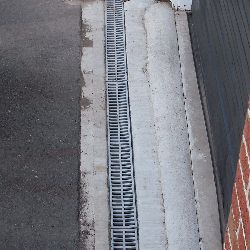Warning
Typical storm drain are often operated independently from sanitary sewer systems. The separation of storm sewers from sanitary sewers helps to prevent sewage treatment plants becoming overwhelmed by the huge influx of water during a rainstorm, which can result in untreated sewage being discharged into the environment. Many storm drainage systems are designed to drain the storm water, untreated, into rivers or streams.
Therefore, do not wash down any spilled oil, gasoline or other hazardous liquids down the catch basin or trench. |
Maintenance
The gratecovering the catch basin or trench drain has to be removable to make periodical cleaning of the basin possible. This cleaning is important and should not be neglected because the runoff water carries a fair amount of soil and organic material that could block the drain pipe and prevent drainage to the storm sewer. |
|
.
|
| Driveway Catch Basin or Trench Drain |
|
| ...... |
|
Need more information? Use our search box
Catch basins. Trench drains.
Sometimes the driveway is sloped towards the house in which case rain water and water from melting snow running down the driveway has to be caught and redirected to prevent it from entering the garage. Chances of flooding the garage are less likely to happen with gravel driveways as they can soak up a fair amount of water. However this may not be sufficient to prevent flooding during a heavy rain storm.
There are basically two methods of re-directing runoff water away from the house to the storm sewer. One is installing a catch basin and the other is a concrete trench the width of the driveway.
The grate covering the catch basin or trench drain has to be removable to make periodical cleaning of the basin possible. This cleaning is important and should not be neglected because the runoff water carries a fair amount of soil and organic material that could block the drain pipe and prevent drainage to the storm sewer.
Catch basin.
Catch basins have to be provided with gratings or grids to prevent large objects from falling in and to prevent personal injury. The bars are widely spaced so that the flow of water is not impeded. The basin usually is a round or square pre-formed concrete pit that is installed slightly below the driveway surface and close to the garage door. The driveway has to be graded in such a way that all runoff water is directed to the catch basin and away from the garage entrance.
Trench drain.
A trench drain is as the name already suggest, a long drain at the end of the driveway. Depending on a few factors, such as landscaping and slope of the driveway, the drain is a bit wider than the garage door or the full width of the driveway. Although the trench drain can be made of different materials, in most cases the trench is made of poured concrete.
The width of the trench is determined by the amount of water it is expected to handle.
Grating for the drain has to be flush with the pavement. For very steep driveways a wider trench drain is recommended to catch all the water during a rain storm. Installing a bump behind the drain will also help to control any water "shooting" past the trench drain.
|

Trench drain
 |
|
|
|